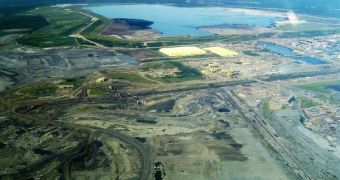In recent years, Canadian officials have been happy to discover that their country has a large reserve of oil at its disposal, which means that the precious stuff no longer has to be carried from far away and imported at high prices. The only catch is that the oil they found was trapped inside tar sand. Extracting the crude from sand is a terribly complex process, and one that generates enormous amounts of pollution. This was made visible before, as birds settling on nearby lakes died, but now the situation is deteriorating even more. Large amounts of poisonous chemicals have been found in water sources that humans use as well, Nature News reports.
In a study released on December 7, experts show that the levels of polycyclic aromatic compound (PAC) chemicals in rivers and other water sources downstream from tar-sand exploitations are well beyond maximum acceptable levels. They also argue that these dangerous compounds are beginning to be retrieved in increasingly larger concentrations, and that they are already taking their toll on the ecosystem. The fish population is hit the hardest, but the main problem is that the water becomes so contaminated, that it's a real risk for humans to use it as well.
The new work shows that the claims the government and the industry made, that the compounds were the results of the naturally occurring erosion of the surrounding oily landscape, are false and purposefully misleading. “Industry's response has always been 'of course there are carcinogens in the water, there's a natural source.' But it defied logic to think that all that was going in was natural,” University of Alberta scientist David Schindler, who is also the lead author of the new study, explains. The investigation basically shows that action needs to be taken to mitigate the effects that PACs have on the surrounding environment. Any delays could mean a bleak fate for the rivers' fish populations, the team says.
The group also shows that the very people who were in charge with protecting the rivers, experts at the Regional Aquatic Monitoring Program (RAMP), exhibited “serious deficits” in performing their work. These included inconsistent sampling designs, a lack of strong government leadership, as well as datasets that were closed to the public. As a habit, RAMP experts never find elevated levels of PACs in river water, and they continue to argue that levels have not gone up since 1997. This is a fine example of public servants working for private interests.
Public safety and environmental conservation are placed on hold because the Alberta tar-sand fields are estimated to hold about 173 billion barrels of recoverable oil, which makes it the second largest deposit after Saudi Arabia.

 14 DAY TRIAL //
14 DAY TRIAL //